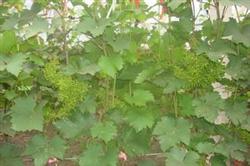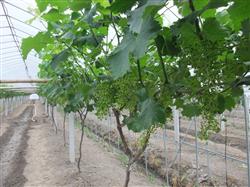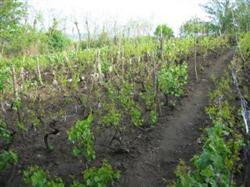Key points of grape maintenance during flowering and fruiting period

First, strengthen the management of fertilizer and water. In production, fertilizer and water management must be carried out according to the phenological phase of grape growth and development. In addition to deep ploughing, fertilization and soil improvement during grape planting, fertilization and irrigation should be carried out at each growth stage according to the needs of grape growth and development. 1. Before sprouting after the grapevine is unearthed, it is necessary to apply quick-acting fertilizers, such as urea and mature human feces and urine, and irrigation to accelerate sprouting. two。 In the shoot growth period, nitrogen, phosphorus and potassium compound fertilizer should be applied and irrigation should be carried out to promote branch growth. Foliar topdressing should also be carried out during the growing period, which is a good way to achieve quick results, less loss, labor-saving and fertilizer-saving. Generally, 3-5 days after foliar fertilizer spraying, the new shoots and leaves can turn dark green and improve the photosynthetic efficiency. The concentration of topdressing outside the root is 0.2%-0.3% urea, 1%-0.3% superphosphate leaching solution, 0.3% potassium dihydrogen phosphate and potassium sulfate 0.5%, 0.1%-0.3% borax, zinc sulfate, magnesium sulfate and manganese sulfate, etc. All the above fertilizers can be sprayed with Bordeaux solution except calcium superphosphate. 3. After the natural physiological fruit drop, entering the fruit expansion stage, we need more fertilizer and water, we should apply rotten human feces and urine, spray the foliar combined with disease prevention and add potassium dihydrogen phosphate quick-acting fertilizer, and irrigate. 4. During the fruit coloring period, urea and potassium dihydrogen phosphate should be mixed to control white rot, downy mildew and powdery mildew. During this period, grapes need more water, and attention should be paid to irrigation in the north. Second, thinning ears and grains. In production, there is a negative correlation between grape yield and fruit quality. Generally speaking, if the yield of grape is low, the fruit quality is better; if the yield is too high, the quality will decline. The yield of grape is composed of ear and grain, that is, it is related to ear size and grain size. Therefore, the yield should be further adjusted by thinning ears and grains in order to improve the quality and benefit. 1. The period of thinning ears and grains. In order to further reduce the unnecessary consumption of nutrients, ear thinning can be carried out when the number of inflorescences or ears per square meter can be estimated after the natural physiological drop of grape fruit. Generally, there are 4 ears per square meter on the scaffolding surface and 5 ears per square meter on the vertical surface. For fruit thinning, the first fruit thinning is carried out when the fruit grows to the size of soybeans (4574, 16.00 and 0.35%); when the fruit enters the hard core stage, it can be seen that the second fruit thinning is carried out when the fruit is big. Thinning fruit should be too dense or too small and deformed fruit. two。 The method of thinning ears and grains. On the basis of removing the excess inflorescences, it is also necessary to check the yield on the shelf. If there is too much overload, be sure to remove the extra ears or grains as soon as possible. According to production experience, every kilogram of fruit must have a leaf area of 1.5 to 2.5 square meters in order to ensure the good quality of berries and make the sugar content of the fruit reach 16 to 17 degrees. Because there is a great correlation between fruit quality and yield and leaf area. Usually large leaf area, high yield and good quality. Third, spraying boron fertilizer to increase production. Boron is a natural mineral and one of the trace elements needed for plant growth and development. It is an important component of grapevine, which is the most abundant in floral organs. Boron can promote the transport of carbohydrates, stimulate pollen germination and pollen tube elongation, which is conducive to the smooth progress of pollination and fertilization and the formation of berries, so as to improve the fruit setting rate. Boron can also increase the content of vitamins and sugars in fruit, improve the quality, increase the intensity of photosynthesis, increase the content of chlorophyll, promote the growth of phloem and xylem of new shoots, increase the number of vessels and accelerate the ripening of branches. Therefore, about 10 days before the grape blossom and at the flowering stage, borax solution with a concentration of 0.2% to 0.3% should be sprayed on the leaf; when spraying carbendazim, chlorothalonil and other agents to control black pox, gray mold and ear axis brown blight, boron fertilizer and potassium dihydrogen phosphate are added. In this way, the fruit setting rate of grapes can be improved obviously. Fourth, spray rare earths and hormones. ① sprays rare earths. Foliar spraying rare earth solution can not only increase the yield, but also increase the sugar content of the fruit. The method is that 0.05% rare earth nitrate solution is sprayed twice in the berry softening period. After spraying liquid, you should prevent exposure to the sun or be washed away by Rain Water, so as not to reduce the efficacy. ② sprays hormone. When the grape fruit begins to soften, spraying hormones such as regulating phosphorus and strengthening hormone can improve the glucose content of the grape fruit. The optimum concentration of spraying phosphorus is 600 × 10 ~ (- 6) and that of spraying zhuangsu is 1200 × 10 ~ 6. Fifth, promote coloring and precocious ripening. ① pin control. For the fruiting shoot with strong growth potential, twisting the upper part of the inflorescence before flowering, or leaving 5 or 6 large leaves to pick the heart can increase the fruit setting rate. ② thinning. When the berries begin to color, remove the old leaves at the base of the new shoots, remove the invalid new shoots covering the ear, improve the ventilation and light transmission conditions, and promote the coloring of the berries. ③ pinched the tendrils. Tendrils not only consume nutrients in the body, but also often wrap around branches and fruits, hindering the growth and development of the plant, so it should be pinched off when it is young. ④ ring cutting. Before the berry coloring, ring cutting at the base of the fruiting mother branch or at the base of the fruiting branch can promote the berry coloring and mature 7-10 days earlier. ⑤ ear bagging. In areas with lower temperature, when the inflorescence stretches out, the inflorescence is covered with a special grape film bag. When the young fruit falls off, the bottom of the bag is torn open and the "bag" is changed into a "tube". This method can make the grapes mature 15 days earlier and prevent fruit cracking.
- Prev

Treatment method of grape inflorescence
The main flowering diseases of grape such as Xiahei and Red Earth are Botrytis cinerea and ear axis brown blight, both of which belong to fungal diseases. Botrytis cinerea, also known as ear rot, has occurred more seriously in recent years. More than 70% of flowers can be destroyed in orchards with severe disease, mainly in the pre-anthesis and florescence damage to Corolla, petiolule, spike pedicel and pollination.
- Next

Three times of medicine for grape disease control
1. Skin. In early spring, first spread a layer of plastic film under the grape tree, and then peel off the skin on the branches, so that it falls on the film, at the same time cut off the diseased branches, together with the skin on the film together in the garden burning treatment. Second, deep ploughing. Combined with the application of grape bud fertilizer, a deep ploughing of the whole garden, the depth of 2...
Related
- Moge, come on! The staff of the peasant association in the producing area of cantaloupe were frightened when the crowd gathered.
- Causes and Solutions of low Fruit setting rate of Apple
- Symptoms and control measures of passion fruit virus disease
- Fruit growing lesson: how do apple orchards keep high yields?
- Can you build orchards in the mountains? What are the pros and cons?
- How to manage the coloring period of Crisson grape?
- This paper introduces the processing technology of two kinds of fig products.
- How much is a month for retired teachers in rural areas by 2020?
- How can strawberry planting increase sugar content? We should pay attention to management in many aspects.
- What are the cultivation techniques on how to improve the yield of golden fruit?

